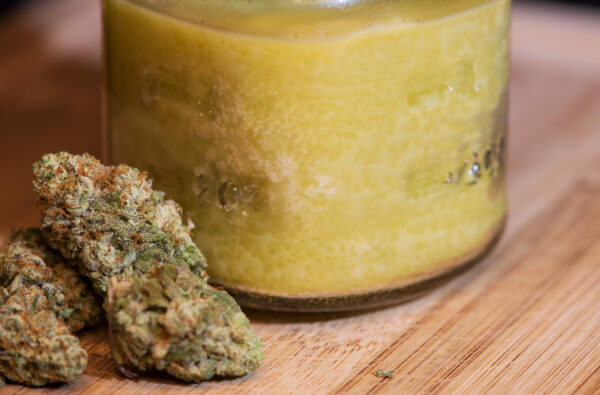This website requires you to be 21 years or older to enter. Please confirm your age below to continue.

December 21, 2020 by Angela Laufer
Cannabis-infused coconut oil is a wonderfully versatile way to infuse and consume cannabis. It is great taken alone, baked into a wide variety of edible recipes, and it can even be used topically in many self-care products. Most strains of cannabis beautifully compliment the flavor of coconut oil, it makes medicating super accessible, and it’s also a great way to use up excess trim, kief or hash from harvest.
Coconut oil is gaining popularity largely because of its ability to be a strong binding agent for cannabinoids, (due to the high concentration of fatty acids (saturated fats)) as well as being a healthier alternative compared to its “fatty” counterparts. Coconut oil also contains other sets of beneficial acids -like lauric acid, which acts as an antimicrobial – that have been known to carry potential health benefits, thus, making it a top contender for those looking for a healthier oil base than butter, canola or olive oil.
Step 1: Decarboxylate!
If you have not already decarboxylated your cannabis, you will need to do so before infusing your coconut oil. In order to activate its psychoactive and medicinal potential, your cannabis flower must be heated slowly at a low temperature. If you would like to know the how and why of decarboxylation, check out our A Beginner’s Guide to Cannabis Decarboxylation before following the rest of this step-by-step guide to making infused coconut oil.

Step 2: Combining Coconut Oil, Cannabis & Lecithin:
In this recipe, we are using ¼ ounce of cannabis per 1 cup of coconut oil.
(As with any other cannabis infused ingredient or recipe, the dosage is based off your personal tolerance, preference and metabolism. Always keep in mind your end dosage and where your comfort level sits, so that you may enjoy responsibly.)
With your double boiler partly filled with water, add your coconut oil, decarboxylated cannabis and sunflower lecithin on low heat until mixed.

NOTE: Lecithin is a commonly used binder when making cannabis edibles. Cooking with it can greatly enhance the structural integrity of your edibles. Lecithin is a phospholipid. In other words, it is a type of fat that binds ingredients together, and acts as an emulsifying agent to bind food that wouldn’t ordinarily mix. When it comes to edibles, lecithin helps ensure that oil-based ingredients bind with water-based ones. Many regard sunflower lecithin as the most superior form. While it’s more expensive, it comes from a minimally processed source. This binder is cold pressed from the seeds and comes in a finely ground powder that is easy to work with. If you are interested in learning more about the benefits of lecithin in your cannabis cooking experiences, read Lecithin: A Secret Weapon in Cannabis Edibles.

Step 3: Cover, Simmer, & Wait 3 Hours:
Make sure you put a cover on your double boiler, to avoid evaporation and losing your cannabinoids during the simmering and infusing process. Put your timer on for at least three hours, and kick back. (: Take a bath, read a book, do some painting, and let your coconut oil, lecithin and cannabis do its magic.

Step 4: Strain:
With a sieve and 2 layered pieces of cheesecloth, slowly pour your cannabis infused coconut oil into a bowl or jar. Avoid squeezing the cheesecloth to make it strain faster, as this will just add more plant material and chlorophyl to your oil.


Step 5: Cool & Store:
Cover your bowl or jar to contain any further evaporation as the cooling process continues. Once cooled completely, you will want to scrape off and/or dab with a cloth any remaining moisture, which will increase the shelf life and purity of your infused oil. The oil’s shelf life is now at least two months and can be extended even further with refrigeration.

Once your cannabis coconut oil is cooled, removed of excess moisture and stored, the possibilities for its use are endless! You can combine your oil with beeswax and aloe to make your own infused cannabis topicals. You can use your coconut oil in place of oil in any recipe of your choosing (try our Cannabis Coconut Oil Peanut Butter Fudge Recipe!) and it can be put into capsules for easy measurable dosing.

Cooking with Cannabis Coconut Oil:
A good starting point for ingesting cannabis edibles is to limit yourself to <5mg THC ; even less if you are new to THC-infused food. It can have the tendency to be a lot stronger, more intense, and can differ drastically from smoking it. For one, the effects can take anywhere from a half hour to 3 hours to fully metabolize, depending on an individual’s unique body and metabolic rate. In addition, because the THC is digested through your liver, and can more readily cross the body’s blood-brain barrier, the high can be stronger and last longer.
With that said, your oil’s potency depends on many factors, from how long and hot it was cooked, to the potency of your starting product, as well as taking into consideration if your strain was indica or sativa leaning. To test the potency and effect of your finished product, try spreading ¼ or ½ tsp on a snack and see how that dose affects you after an hour or so. Titrate your dose as desired, and you can then use this personalized “standard” dose as a baseline for your recipes.
Happy Cooking!